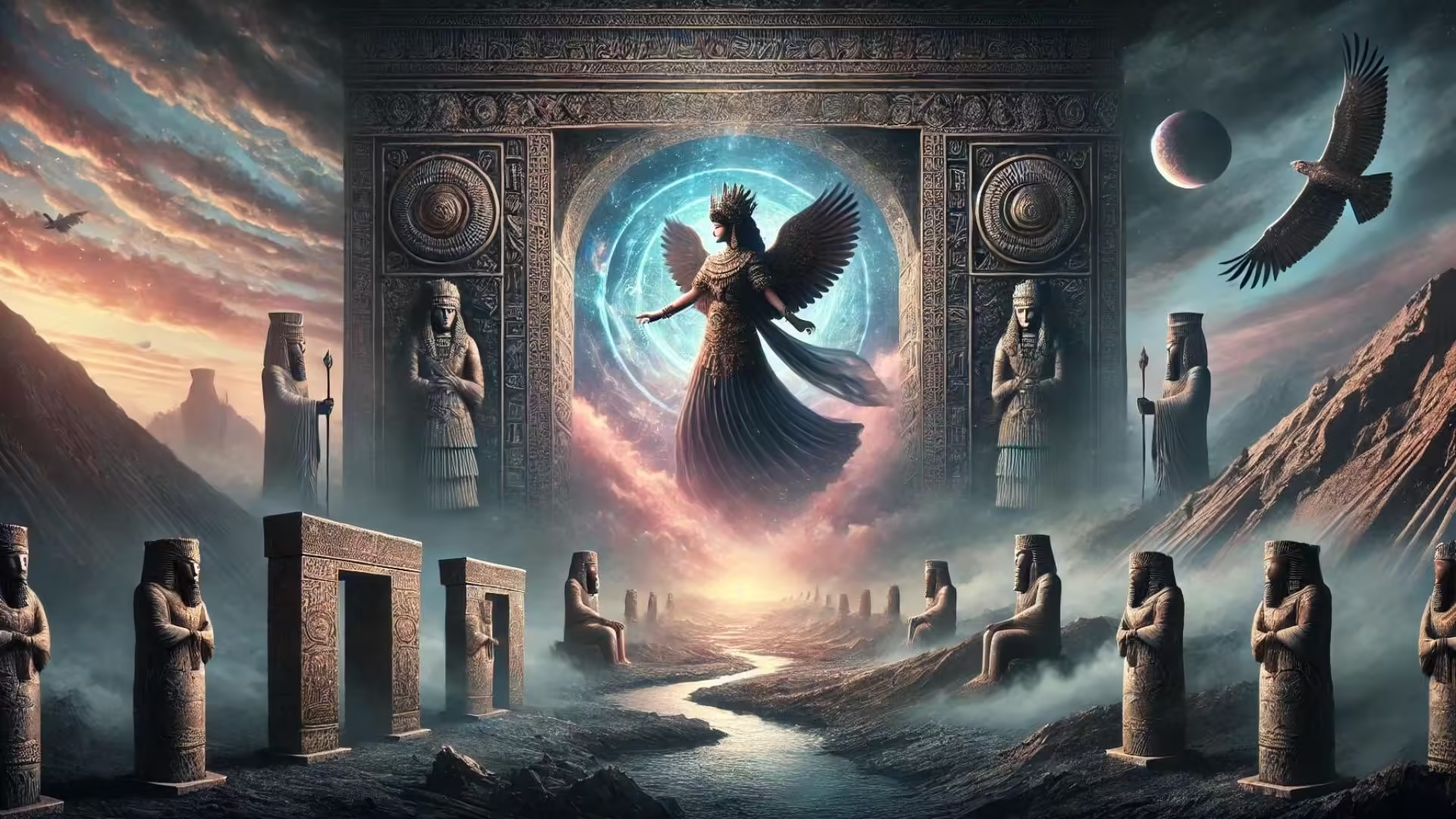Ishtar, the powerful goddess of love, war, and fertility, holds a prominent place in ancient Mesopotamian mythology. Her story, The Descent of Ishtar, is a tale of power, sacrifice, and the inevitable encounter with death. But beyond its mythological grandeur, this story offers timeless insights into human nature and the cycles of life. As we unravel this myth, you’ll see how it speaks to real-life experiences and why understanding these ancient tales can still enrich our lives today.
The Myth: A Journey to the Underworld
The tale begins with Ishtar, driven by her desire to confront her sister, Ereshkigal, the queen of the underworld. As Ishtar descends through the seven gates of the underworld, she is stripped of her garments, symbolizing the gradual loss of her power. By the time she reaches Ereshkigal, Ishtar stands vulnerable, stripped of all her divine might.
Upon confronting her sister, Ishtar is struck dead and hung on a hook—her life force drained. As Ishtar languishes in the underworld, the world above suffers. Without her presence, fertility ceases, and the earth becomes barren, reflecting the interconnectedness of the divine with the natural order.
This stasis continues until the gods intervene, sending a messenger to resurrect Ishtar. Her return from the underworld signifies the restoration of life, fertility, and order.
The Symbolism: Power, Death, and Renewal
The Descent of Ishtar is more than a dramatic tale of sibling rivalry; it’s a profound exploration of life’s inevitable cycles—descent, death, and rebirth. The story’s focus on power loss and eventual renewal speaks to a universal human experience: that of enduring hardship and emerging stronger.
Think of times when you’ve faced significant challenges. Whether it’s a loss, a failure, or a setback, these moments can feel like personal descents into an “underworld.” You may feel stripped of your power, much like Ishtar. However, just as Ishtar returns, bringing life back to the world, our own struggles often lead to renewal. After periods of difficulty, we frequently come back stronger, wiser, and more aware of our inner strength.
Why Does This Myth Matter Today?
At first glance, The Descent of Ishtar may seem like an ancient story about gods and goddesses. But at its heart, this myth is deeply relevant to modern life. It’s a reminder of the human ability to recover from adversity, the natural cycles of life and death, and the power of persistence.
Ishtar’s journey highlights that even the most powerful beings—divine or human—must confront vulnerability and loss. This concept can resonate with anyone navigating the ups and downs of life.
Consider someone going through a difficult period, such as a career setback or a personal loss. Like Ishtar’s descent, they may feel like they’ve lost their sense of purpose or identity. But, through resilience, they emerge from the darkness—stronger, more focused, and ready to reclaim their lives. Just as Ishtar’s return marks the end of the world’s barrenness, personal renewal can restore vitality and meaning to one’s life.
Cultural Significance: The Cycles of Life and Death
In Mesopotamian culture, Ishtar was seen as the embodiment of the life-death cycle. Her myth was symbolic of the natural rhythms of the earth: the seasons of planting, harvest, and fallow. Ishtar’s descent parallels the dying of the earth in winter, while her return heralds the spring and the renewal of life.
In many agricultural societies, the cyclical nature of life—birth, growth, death, and rebirth—remains a powerful metaphor. Even today, farmers observe these cycles as they plant in spring, harvest in summer, and prepare for the dormancy of winter. The rhythm of nature reflects the deeper truths within the human experience.
Lessons We Can Learn from Ishtar
- Embrace Vulnerability: Ishtar’s story teaches that true power sometimes comes from embracing vulnerability. When we let go of what we cling to—whether that’s control, status, or ego—we open ourselves to growth and renewal.
- Understand Life’s Cycles: Just as Ishtar’s descent and return symbolize the life-death-rebirth cycle, so too do we experience seasons in our own lives. Understanding and accepting that life has its highs and lows can help us navigate difficult times with resilience.
- Power Lies in Persistence: Ishtar’s return to the world is a reminder that we all have the power to overcome adversity. The descent may be painful, but persistence and resilience can lead to personal transformation.
Think of someone who has experienced a major setback, like losing a job. The initial shock may feel overwhelming, much like Ishtar’s death in the underworld. But through determination and persistence, they can bounce back—perhaps finding an even better opportunity and discovering new strengths along the way.
The story of The Descent of Ishtar is as much about the human condition as it is about gods and goddesses. It speaks to the inevitable cycles of life—moments of vulnerability, loss, and eventual renewal. In understanding this ancient myth, we gain insights into our own lives, learning how to navigate the difficulties we face and emerge stronger on the other side.
The next time you face a challenge or a personal setback, remember Ishtar’s journey. Just as she returned from the depths of the underworld, you too have the strength to rise from adversity. Embrace the difficult moments in your life, knowing they are part of the natural cycle of growth and renewal.
Expand Your Vocabulary
- Descent
Meaning: A downward journey or movement, often symbolizing a decline or loss of power.
In Context: In the myth, Ishtar’s descent into the underworld symbolizes her losing power and status.
Everyday Use: We often use the word “descent” to describe someone’s fall from success, such as “his descent into failure was rapid after losing his job.” - Underworld
Meaning: A mythical realm where the dead reside, ruled by gods or beings associated with death.
In Context: Ishtar descends into the underworld, ruled by her sister, Ereshkigal.
Everyday Use: The term “underworld” can also describe the criminal world, as in “the city’s underworld is controlled by organized crime.” - Fertility
Meaning: The ability to produce life, often associated with nature, reproduction, and growth.
In Context: Ishtar was the goddess of fertility, and her absence caused the earth to become barren.
Everyday Use: Fertility is used in both agricultural and biological contexts, such as “fertile soil produces abundant crops” or “fertility treatments help couples have children.” - Barren
Meaning: Unable to produce life or growth; empty.
In Context: The earth becomes barren without Ishtar’s presence, symbolizing a lack of life and growth.
Everyday Use: Barren is commonly used to describe land, like “the desert is barren and dry,” or even a lack of ideas, as in “his mind felt barren after hours of work.” - Renewal
Meaning: The process of being made new again, symbolizing revival or restoration.
In Context: Ishtar’s return from the underworld represents the renewal of life and fertility on earth.
Everyday Use: You might talk about a sense of renewal after a vacation or break, such as “I felt a sense of renewal after the weekend.” - Vulnerability
Meaning: The state of being open to harm or attack, often tied to emotional or physical exposure.
In Context: Ishtar’s descent strips her of her power, making her vulnerable.
Everyday Use: People often feel vulnerable when they open up emotionally to others, like “sharing my feelings left me feeling vulnerable.” - Persistence
Meaning: The quality of continuing firmly in a course of action despite difficulties or opposition.
In Context: Ishtar’s eventual return to life shows persistence in overcoming the obstacles of the underworld.
Everyday Use: Persistence is key in many areas of life, such as “his persistence in studying every night paid off with high exam scores.” - Interconnectedness
Meaning: The state of being connected or linked with others or with different parts of a system.
In Context: Ishtar’s role in the myth shows the interconnectedness of the gods and the earth’s natural cycles.
Everyday Use: We might refer to the interconnectedness of global economies or ecosystems, as in “the interconnectedness of the internet brings people together.” - Symbolism
Meaning: The use of symbols to represent ideas or qualities.
In Context: The stripping away of Ishtar’s garments is a symbol of losing power.
Everyday Use: Symbolism is used in art, literature, and everyday language, such as “the dove is a symbol of peace.” - Sacrifice
Meaning: The act of giving up something valuable for the sake of something or someone else.
In Context: Ishtar sacrifices her power and status to descend into the underworld.
Everyday Use: Sacrifice is often part of personal and professional life, as in “parents sacrifice time and energy for their children’s well-being.”
Let’s Talk
- Ishtar’s descent into the underworld represents vulnerability and loss of power. Have you ever experienced a moment in your life where you felt vulnerable or powerless? How did you overcome it?
- The myth talks about cycles of death and renewal. What personal or professional experiences have you had that reflect these cycles? How did renewal manifest in your life after a difficult period?
- The concept of interconnectedness is central to this myth. In what ways do you see the interconnectedness of your actions and their impact on the people around you or the environment?
- Ishtar’s journey required her to give up her power before regaining it. Do you think there are situations in life where giving up control leads to personal growth? Can you think of any examples from your own life?
- The story of The Descent of Ishtar reflects natural cycles, such as the seasons. How do you see these cycles playing out in your own life, whether through changes in career, relationships, or personal growth?
- Symbolism plays an important role in this myth. Are there symbols in your daily life or culture that hold deeper meanings for you?
- The story of Ishtar is about persistence in the face of adversity. How can you apply this concept of persistence to challenges you’re currently facing in your life?
- The theme of sacrifice is also evident in the myth. What sacrifices have you made in your life, and what were the results? Were they worth it in the end?
- How do you see myths like Ishtar’s journey still relevant today? What lessons can we learn from ancient stories that apply to modern challenges?
Take time to reflect on these questions, and feel free to share your thoughts in the comments or discuss them with those around you. Ancient myths have much to teach us, and by exploring these timeless stories, we gain new perspectives on our own lives.










0 Comments